Portland Metro Area Birding Hotspots
The Portland metropolitan region offers a rich array of birding opportunities in its many wildlife refuges and natural areas. With forests, wetlands, grasslands, buttes, and rivers, nature lovers can explore a great number of habitats both within the city limits, and within a forty five minute drive.
Birders can delight in seeing species like the Sandhill Crane, Bald Eagle, Pacific Wren, Northern Pygmy-Owl, Brown Creeper, Chestnut-backed Chickadee, and Acorn Woodpecker as they explore the beauty of the greater Portland metro area. See below for detailed information on 15 birding hotspots in the greater Portland metro area.
Bird Alliance of Oregon Wildlife Sanctuary
At 172 acres and just ten minutes from downtown Portland, the Bird Alliance of Oregon Wildlife Sanctuary is a wonderful place for birders, families, and nature enthusiasts to visit. Folks can explore four miles of trails through forest habitat, a pond, Balch Creek and Bones Creek, and even a stand of old growth trees. Tune your senses to the large variety of life all around you, from native plants to birds and other wildlife. The sanctuary is free and open from dawn until dusk every day.
We also have a Nature Store on site that sells optics, field guides, gifts and more, and a Wildlife Care Center where we treat more than 3,000 native wildlife each year.
Birds You Might See or Hear: Pacific Wren, Spotted Towhee, Chestnut-backed Chickadee, Northern-pygmy Owl, Varied Thrush, Golden-crowned Kinglet, Pileated Woodpecker, Steller’s Jay, Black-headed Grosbeak. View our full bird species list.
Location: 5151 NW Cornell Rd. Portland, OR 97210
Public Transit: There is no direct Service within 1.5 miles; but we can be accessed by the lower MacLeay trail, which begins 6 blocks west of the bus stop on Northwest Thurman ST. and Northwest 27th Ave. The stop is served by TriMet buses 15 and 77. After you walk to Upshur ST one block north and walk the six blocks west, the hiking trail takes you up hill along Balch Creek Canyon for about 45 minutes before reaching the Portland Wildlife Wildlife Sanctuary.
Accessibility: Most of Bird Alliance of Oregon’s indoor facilities are wheelchair accessible including our Interpretive Center, Nature Store, classroom space, and Wildlife Care Center. Trails are not wheelchair accessible and have steep elevation changes. See more details on accessibility here.

Oaks Bottom Wildlife Refuge
This 185-acre refuge protects Oaks Bottom, a floodplain wetland along the Eastern side of the Willamette in SE Portland that was once slated for landfill and industrial development. Marsh, wet woods and meadows, and open water make for excellent diversity both in the landscape and the bird life—the latter includes 157 annually recorded species. This is one of the most popular sites in Portland for viewing migrating and wintering waterfowl, as well as Ospreys, and Great Blue Herons from a massive rookery on nearby Ross Island. Wetland and woodland songbirds abound. Trails can be muddy where not paved.
Birds You Might See or Hear: Northern Pintail, Great Blue Heron, American Coot, Osprey, Red-winged Blackbird, Wood Duck, Brown Creeper.
Location: SE Sellwood Blvd & SE 7th Avenue, Portland, OR 97202
Public Transit: The entrance area is ⅓ of a mile from a stop on TriMet’s bus 70 to Milwaukee on Southeast 13th Ave and Selwood, ¾ of a mile from a stop on the 19 bus going to Downtown Portland at Southeast Bybee and Milwaukee, ¾ of a mile from the Northbound 70 stop at Southeast 17th Ave and Rex, ¾ of a mile from a stop on the 19 bus from downtown at Southeast Bybee and Southeast 17th Ave.
Trail Accessibility: There are extensive paved and wheelchair accessible trails, as well as dirt paths.
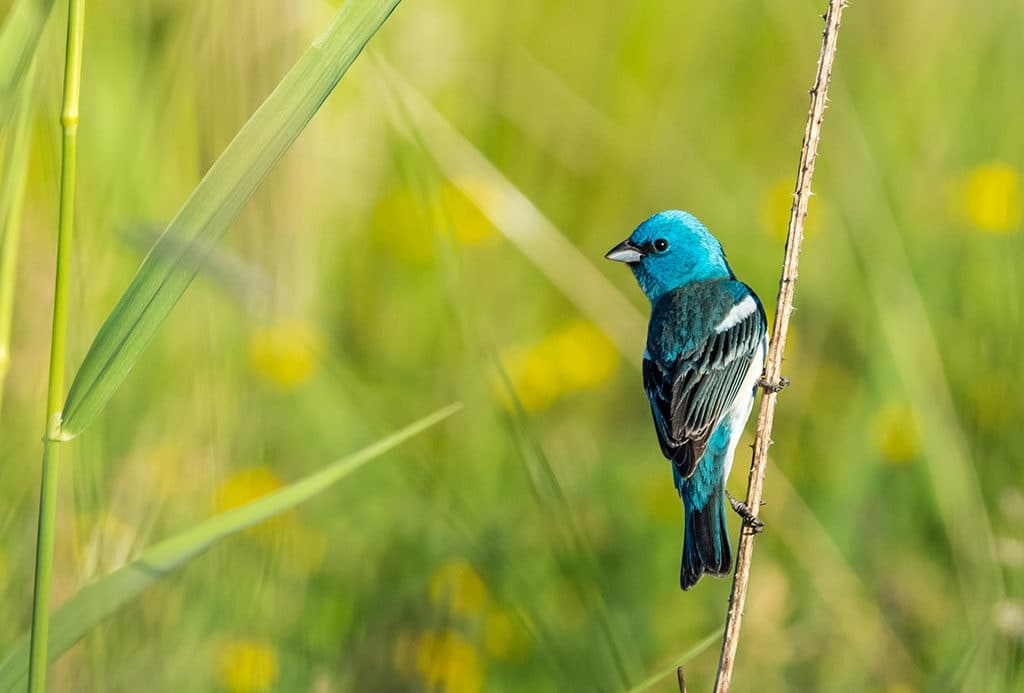
Powell Butte Nature Park
This park sits upon another one of Southeast Portland’s four extinct Volcanic Cinder cones (Buttes), meaning there is a short but steep climb to a summit several hundred feet above otherwise gently sloping terrain. The 614-foot summit affords fantastic views over a 610 acre wooded landscape and sites beyond, as well as chances to spot Bald Eagles and Red-tailed Hawks. This park includes 9-miles of paved and unpaved trails, allowing visitors pedestrian, biking and horseback access to red cedar dominated forest, hawthorn shrubland, meadows, and riparian habitat along Johnson Creek (one of the Willamette River’s major tributaries). Meadowlands here hosts Killdeer, Barn owls, American Kestrels and Western Bluebirds, while locally rare Lazuli Buntings are known from the shrubbier habitat. The park is also conveniently located adjacent to some of the city’s major arteries, including Powell Blvd and Holgate Blvd, plus the 22 mile Springwater Corridor biking and pedestrian trail.
Birds You Might See or Hear: Red-tailed and Sharp-shinned Hawk, Bald Eagle, American Kestrel, Bufflehead, American Widgeon, Anna’s Hummingbird, Mourning Dove, Western Bluebird, Lazuli Bunting, Band-tailed Pigeon.
Location: 16160 SE Powell Blvd, Portland, OR 97236
Public Transit: There are no Light rail or bus stops within a mile of the park’s main entrance. There is a stop for the 10 Bus on Harold Street and Southeast 136 Ave. about 1.3 miles away from the main entrance, and about .5 miles from the Ellis Street access path into the property. This path leads to the Cedar Grove Trail after about 330 feet, which in turn connects with several other trails, beginning with the Douglas Fir trail after about 350 feet.
Accessibility: There are both paved roads and well-kept gravel and compacted dirt paths here for bikers, hikers, horseback riders, and wheelchair users, though the terrain is often steep.
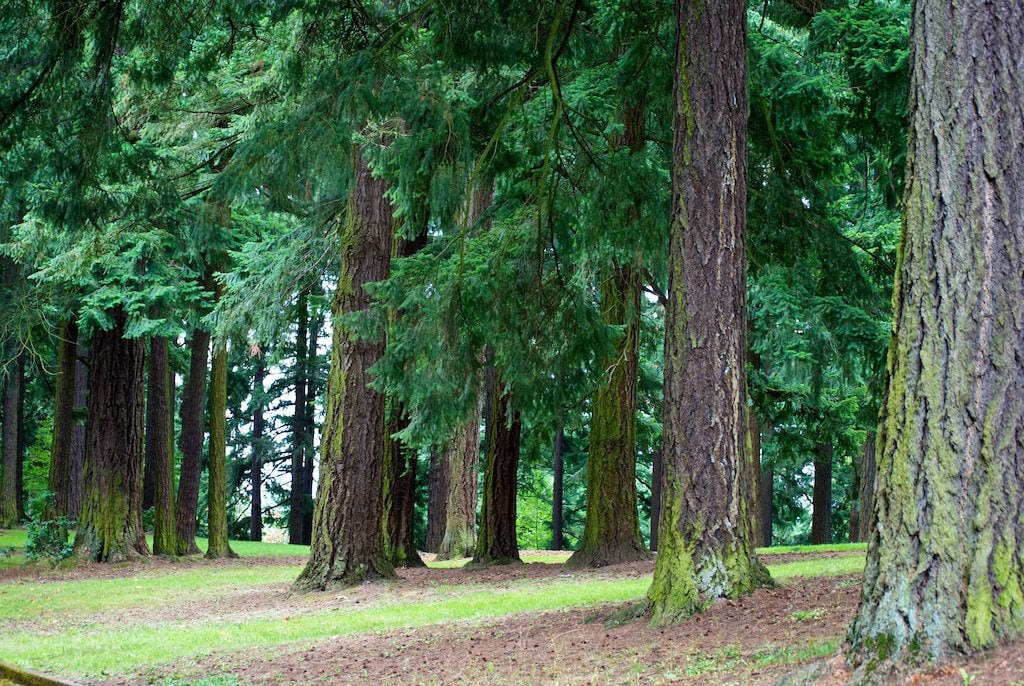
Mt. Tabor Park
Mt. Tabor is a mixed use park of 190-acres readily accessed via bus in a well populated area of SE Portland. While the park features summer concerts and playgrounds, it is also well-known to birders for the mature Douglas fir/big-leaf maple forest on and about its steep slopes. This extinct or dormant volcanic vent and cinder cone rises prominently for several hundred feet above the surrounding neighborhood and Willamette valley to about 630 FT above sea-level. Swifts, red-tailed hawks, and additional raptors may be seen above the trees as one takes in the views from the top, but what draws in birders are the small long-distance ‘neotropical’ migrants, like warblers and flycatchers, seen so frequently in April and May while hiking the many paved and unpaved trails. Some waterfowl are commonly seen on or along the decommissioned reservoirs. Overall, nearly 40 species have been confirmed to nest in the park, and about 100 more have been spotted.
Birds You Might See or Hear: Chestnut-backed Chickadee, Yellow-rumped Warbler, Pacific-Slope flycatcher, Spotted Towhee, Red-tailed Hawk, Cooper’s Hawk, Vaux’s Swift.
Location: 6220 SE Salmon St, Portland, OR 97215
Public Transit: There are several bus routes that run within a mile of Mt. Tabor, including: two stops at Southeast 60th Ave and Salmon St on the North/South-going TriMet 71 bus, two stops for the 15 bus ¼ of a mile away on Southeast Belmont and Southeast 60th Ave, and two ¾ of a mile away for the 20 bus routes at East Burnside and Southeast 60th Ave.
Trail Accessibility: There are paved paths, including road access to the summit. Much of the terrain is steep, and there are dirt paths and stairs in areas.

Ridgefield National Wildlife Refuge
Ridgefield NWR is a magnificent 5,228 acre piece of federally protected land on the Washington side of the Columbia River. The refuge protects premier grassland, marsh, and woodland habitat along the Pacific Flyway. Ridgefield NWR was originally established to protect wintering populations of the Dusky Canada Goose subspecies, but the wetland landscape also protect such favorites as Sandhill Cranes, Hooded Mergansers, and Green-winged Teals in the winter, plus nesting American Bitterns, Gadwalls, and Pied-billed Grebes. Red-eyed Vireos approach the southwestern end of their nesting range in the refuge’s woodlands. (See a comprehensive list of bird species known from Ridgefield NWR here.)
Birds You Might See or Hear: Pied-billed Grebe, Great Horned Owl, Northern Harrier, Bald Eagle, American Coot, Northern Shoveler, Hooded Merganser, Sandhill Crane.
Location: 1071 S Hillhurst Rd, Ridgefield, WA 98642
Public Transit: Accessible by car only.
Accessibility: Most visitors take the auto route, making this a great option for folks with limited mobility. The Oaks to Wetlands Trail is open year-round. The Kiwa Trail is open from May 1 through September 30. Both are flat dirt trails.
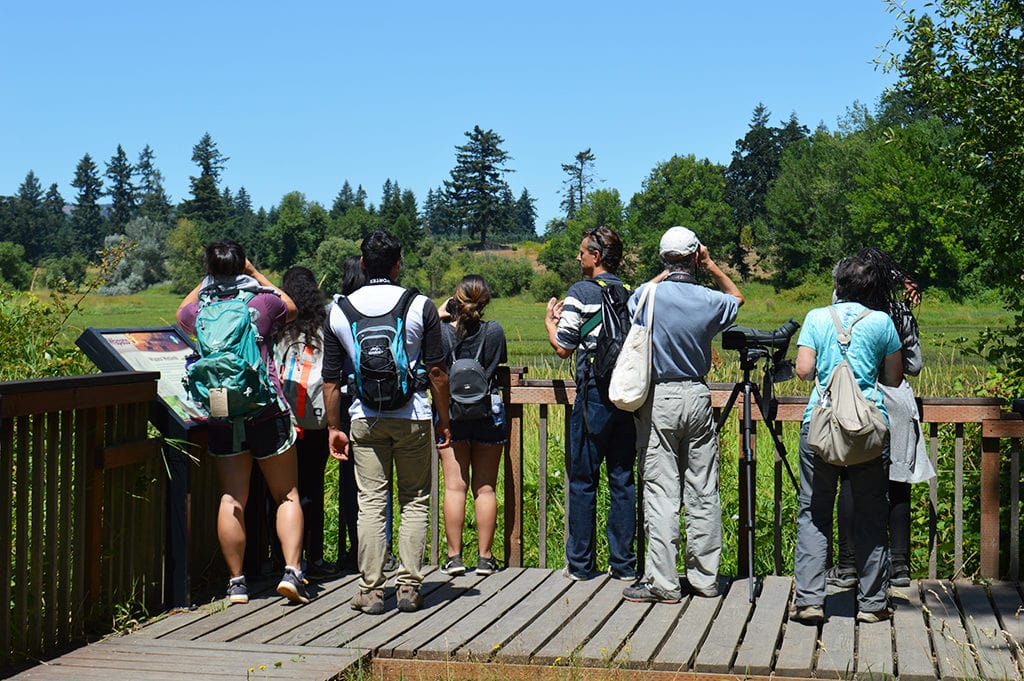
Sauvie Island
This renowned state-owned site covers a massive 12,000 acres on its namesake island near the mouth of the Willamette River in North Portland. This is a top destination for all Portland area birders, and features fine examples of some of the region’s rarest and most distinct habitat. Oregon white oak woodlands and adjacent meadows host the likes of Cedar Waxwings, Bullock’s Orioles, Purple Finches, and Western Meadowlarks, while lakes, ponds, navigable streams, sandy shores and thickly vegetated wetland are top stop-overs for Northern Pintails and Sandhill cranes, and year-round homes for Bald Eagles, American Coots, and Wood Ducks. In all at least 275 bird species are provided habitat during the year on Sauvie Island. If you have the chance, this is one location you shouldn’t miss!
Birds You Might See or Hear: American Kestrel, Bald Eagle, Snow Goose, Trumpeter Swan, American Coot, Cedar Waxwing, Great Horned Owl, Purple Martin, American Goldfinch, Black-headed Grosbeak.
Location: Various points around Sauvie Island. See list here.
Public Transit: There is no public transit within a mile of major entrances to the wildlife area—the TriMet 16 bus will take you to and from just one stop on the large island, though there is an osprey nest one can view very close to this stop.
Accessibility: Trails are gentle and low-lying, but often flood, and thus may feature ruts and puddles or seasonally submerged areas. The Wappato State Greenway trail loop is well maintained and popular. The Raccoon Point path is short and well-maintained, and takes walkers atop a dike for excellent viewing. Other trails may feature encroaching brambles or grass.
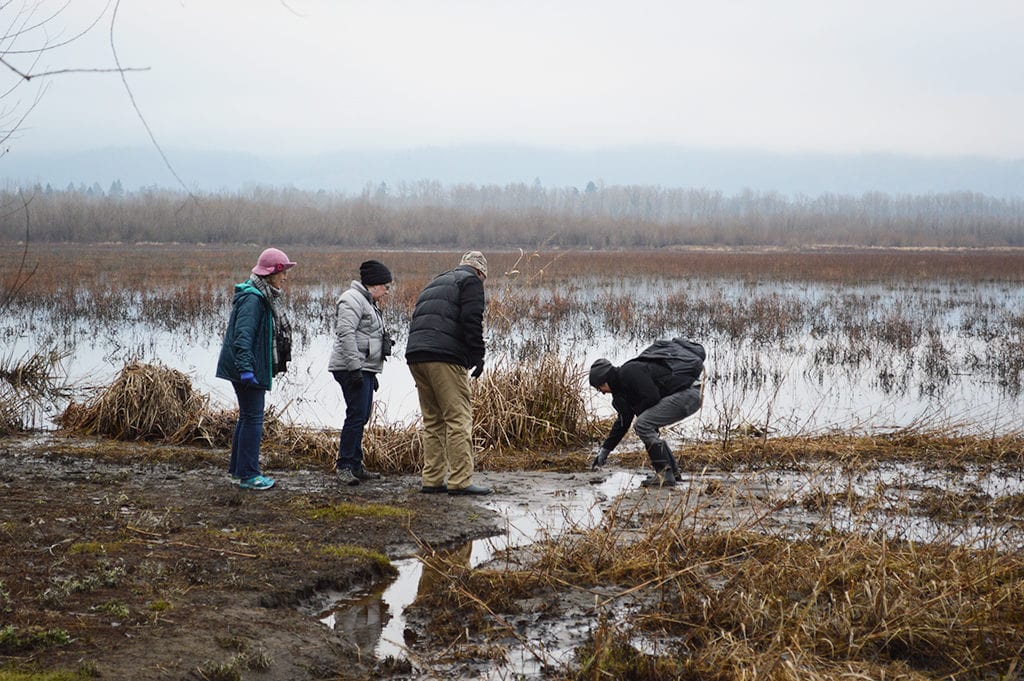
Smith and Bybee Wetlands Natural Area
This 2,000-acre public park between the Columbia River and Columbia Slough is named for the two lakes representing the centerpiece to one of the country’s largest urban wetlands. Together with open water and pond lily dominated shallows, forests of wetland-loving cottonwoods and Oregon ash are interspersed with both shrubby and grassy wetlands. Thus, the birding runs the gamut of the region’s wetland species, including Marsh Wrens, Willow Flycatchers, Common Yellowthroats, Bullock’s Orioles, Cinnamon Teals, and Great Egrets. In 2003, the metropolitan government began management of a hydrologic control system, meant to restore original water cycles and support waterfowl and fish populations upon a landscape formerly heavily degraded by dredging, dumping and levies. The area remains a major wetland restoration area, still surrounded by warehouses and other industrial sites, but it also connects with the city bus system and 40 Mile Loop bike path network, thus affording easy visitation, and a phenomenal experience for all birders.
Birds You Might See or Hear: Cinnamon Teal, Marsh Wren, Yellow Warbler, Common Yellowthroat, Bullock’s Oriole, Willow Flycatcher, Great Egret.
Location: 5300 N Marine Dr, Portland, OR 97203
Public Transit: The 11 Bus to St. Johns to the North stops on the 5300 block of North Marine Drive about a half mile from the location. Going the opposite way towards downtown, the 11 bus stops on the block about 1/3 of a mile away from the entrance.
Accessibility: The Interlakes trail is a gentle paved trail with some tree roots. The trail ends at a wheelchair accessible viewing platform. The parking and restrooms are wheelchair accessible as well. Biking is not allowed within the park, although canoeing and kayaking are allowed in the spring, and there is a bike rack.
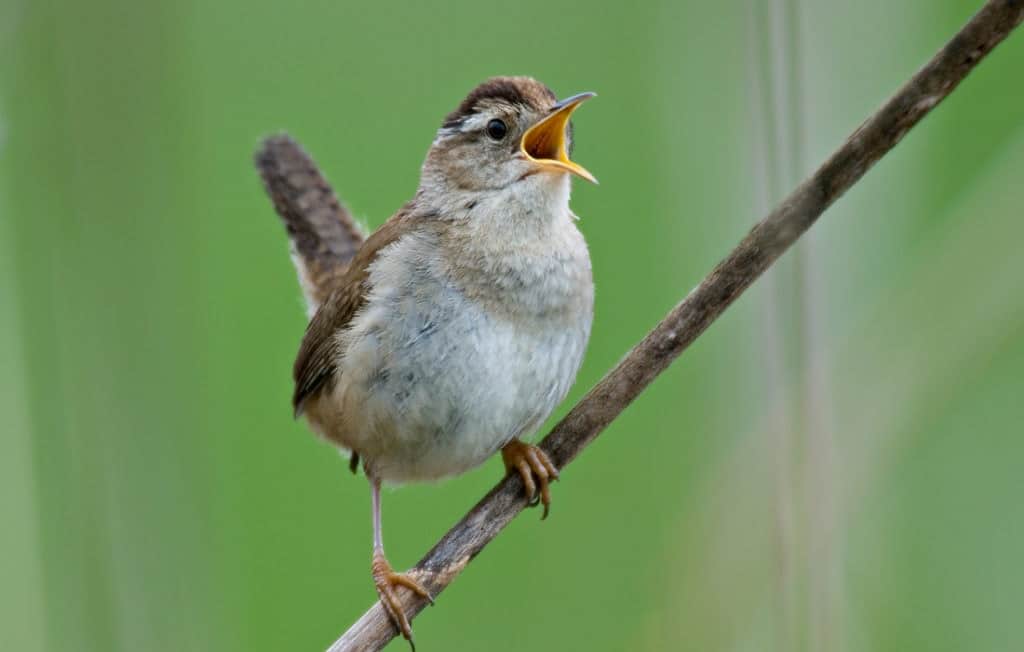
Tualatin River National Wildlife Refuge
A top birding hotspot both for the Tualatin River Valley and the Portland region as a whole, this 1,856 acre nationally protected area features premiere marshland, native prairie, and lowland forest just 15 miles from Portland proper. Five miles of trails and a viewing platform give visitors different vantage points for spotting nearly 200 bird species. Among these are diverse waterfowl like Trumpeter Swans, Green-winged Teals, Green Herons, and Sandhill Cranes, plus small songbirds like forest-dwelling Pacific-slope Flycatchers and Black-headed Grosbeaks, and Yellow Warblers and Marsh Wrens of the wetlands.
Birds You Might See or Hear: Sandhill Crane, Northern Pintail, Green Heron, Green-winged Teal, Trumpeter Swan, Black-headed Grosbeak, Yellow Warbler, Pacific-slope Flycatcher, Marsh Wren.
Location: 19255 SW Pacific Hwy, Sherwood, OR 97140
Public Transit: Take the bus right to the front entrance! Check out the Tri-Met bus schedules for Route 93 (daily) and 94 (weekdays only). We’re at Stop ID# 12743. Look for the kiosk at the bus stop for maps and information. Follow the trail from the bus stop, 100 yards to the Wildlife Center and main trailheads.
Accessibility: An enormous window in the store provides a breathtaking view of the Refuge’s largest section, with views of the seasonal wetland and surrounding oak savannah and riparian corridors. Spotting scopes are always set up for close-up views of the waterfowl, raptors, and mammals that call this place home throughout the year.
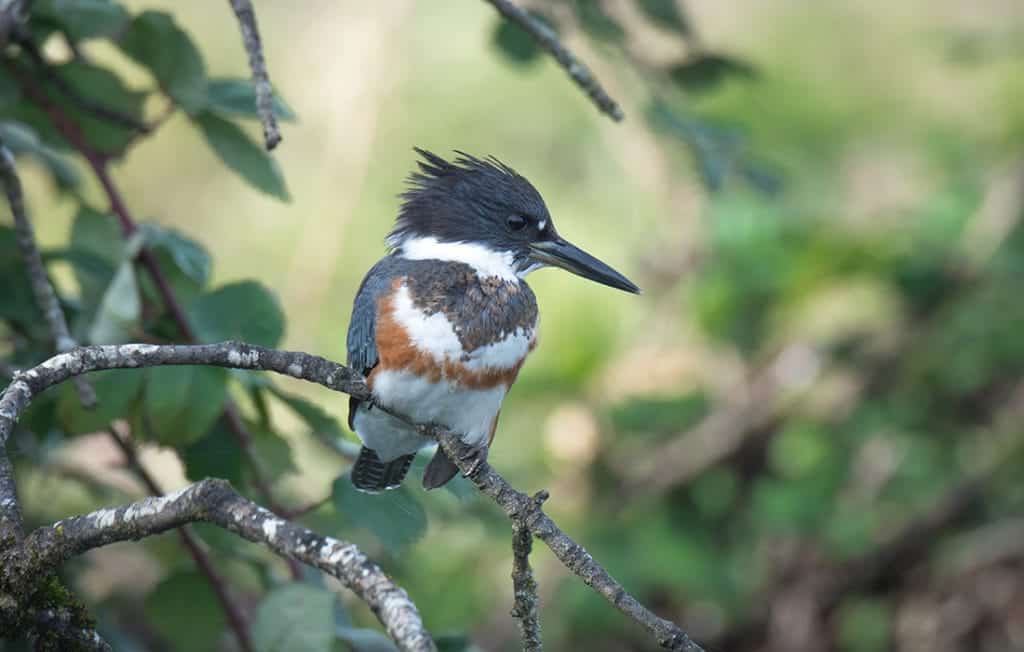
Whitaker Ponds Nature Park
This nature park is home to two ponds, a ½ mile loop trail, an ecoroof-covered gazebo, and a canoe launch into Whitaker Slough. The two ponds are surrounded by a black cottonwood forest which has been enhanced over the past 15 years with thousands of native plants. Native shrubs and wildflowers support local pollinators in the summertime, and the path around the West pond park highlights plant communities from the Northwest. A sloping ramp leads down to an observation dock on the west pond, from which visitors can see fish, frogs, and water bugs. A second dock into Whitaker Slough is located on the north side of the park, and offers excellent access for canoes and kayaks.
Birds You Might See or Hear: Cackling Goose, Wood Duck, Bufflehead, Common Goldeneye, Belted Kingfisher, Great Horned Owl, Willow Flycatcher, Townsend’s Warbler, Hutton’s Vireo.
Location: 7040 NE 47th Ave, Portland, OR 97218
Public Transit: The best access to the park is from the entrance at 7040 NE 47 Ave, a ¼ mile north of Columbia Blvd. TriMet bus #75 makes a stop at the corner of NE 47th Avenue and Columbia Blvd and visitors can walk north from there to the park entrance. Bike racks are located inside the entrance near the west pond.
Accessibility: Natural area with paved pathways to the ecoroof gazebo and first bridge. The trail to the western pond is relatively flat with packed gravel. Two ADA parking spots are available for use.

Cooper Mountain Nature Park
Cooper Mountain Nature Park covers 230-acres of land overlooking the Willamette Valley near the edge of Beaverton, about 10 miles from downtown Portland. The property is operated by the Portland metropolitan government, and the Tualatin Hills Park and Recreation District. The property’s 3 ½ miles of hiking trails lead visitors through three distinct habitats: Oregon white oak woods (hosting mourning doves and nesting black-headed grosbeaks), conifer forests (with Steller’s jays and migrating olive-sided flycatchers), and prairie (featuring western bluebirds and red-winged blackbirds). Excellent views of the Chehalem Mountains also give birders a chance to spot soaring raptors, including Bald Eagles and Red-tailed Hawks.
Birds You Might See or Hear: Black-headed Grosbeak, Mourning Dove, Olive-sided Flycatcher, Steller’s Jay, Bald Eagle, Western Bluebird, Red-wing Blackbird.
Location: 18895 SW Kemmer Rd, Beaverton, OR 97007
Public Transit: Not accessible by public transit.
Accessibility: Trails are gravel with a mostly downhill grade. Restrooms and picnic area is paved and wheelchair accessible.
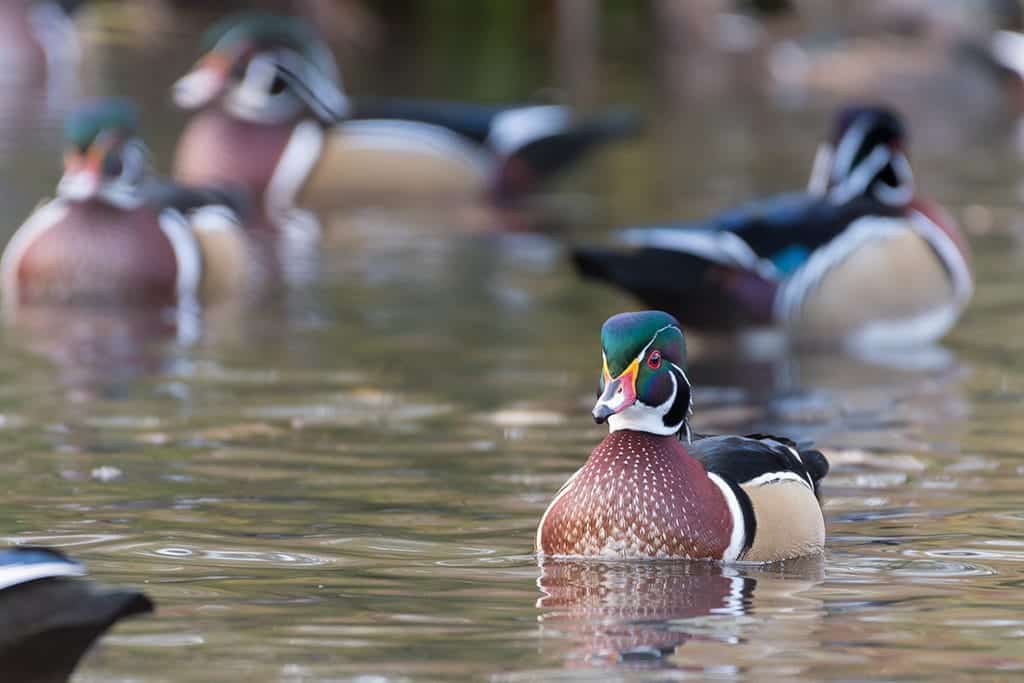
Crystal Springs Rhododendron Garden
This peaceful and elegant garden is primarily recognized for its displays of thousands of often rare species and cultivars of rhododendrons and magnolias; but the lush vegetation, combined with a pond, wetlands, and a stream with waterfalls makes it attractive to birders. Crystal Springs Creek flows from the adjacent Reed Canyon, a popular nature reserve on the Reed College campus with wetlands, abundant native vegetation, and walking trails that can easily add to your birding experience. The garden’s waters allow one to get a close view of numerous waterfowl in migration, including Wood Ducks, Buffleheads, and Hooded Merganser. Greater white-fronted, Canada, and cackling geese are in ample supply in the winter. Some woodland birds, like Violet-green swallows, Brown Creepers, and Pacific Wrens accompany Great Blue Herons in Reed canyon.
Birds You Might See or Hear: Bufflehead, Greater White-fronted Goose, Cackling Goose, Hooded Merganser, Wood Duck, Great Blue Heron, Pacific Wren, Brown Creeper, Violet-green Swallow.
Location: 5801 SE 28th Ave, Portland, OR 97202
Public Transit: The 10 Bus line stops a half mile north of the garden at Steel and Southeast 28th Ave going Downtown or eastward. The 17 bus stops at Southeast Holgate and Southeast 28 Ave going both ways about ¾ of a mile north of the garden.
Accessibility: Very—paths in the garden are solid, wide and gentle. Some of the trails at Reed Canyon are wheelchair accessible, although trails that follow just along the stream at the bottom of the canyon are mostly dirt, and are often narrow or with steps and roots.

Fernhill Wetlands
Fernhill Wetlands is a nature preserve of about 700-acres containing a 90-acre habitat restoration site found in and owned by the Portland suburb of Forest Grove, and managed in conjunction with Bird Alliance of Oregon. The aim of the management project, begun in 2014, has been to simultaneously restore wetland vegetation to former sewage retaining ponds and offer a natural means of treating local waste water. Early results show a clear increase in species like Virginia Rails, American Bitterns, and Soras, ducks like Gadwalls and Mallards, and wetland loving songbird species like Red-winged Blackbirds, Common Yellowthroats, and Marsh Wrens. Thousands of waterfowl can be seen daily in the fall, winter and spring. Trails at the site provide access for nature lovers, and indeed this is one of the most popular draws for area birders seeking migratory species.
Birds You Might See or Hear: Sora, American Bittern, Virginia Rail, Gadwall, Common Yellowthroat, Marsh Wren, Red-winged Blackbird, Pied-billed Grebe.
Location: 97117, 1399 SW Fern Hill Rd, Forest Grove, OR 97116
Public Transit: Ride TriMet’s Frequent Service bus line 57 to Pacific Hwy and Maple; walk or bike about a mile south on Maple St, which becomes Fern Hill Road when it crosses TV Hwy. There are sidewalks most of the way.
Accessibility: The main loop around Fernhill Lake is 1.1 miles and flat. Trails are paved only near the parking lot, restroom and shelter. The trails are largely gravel around the ponds and marsh. There are limited places to stop and sit.
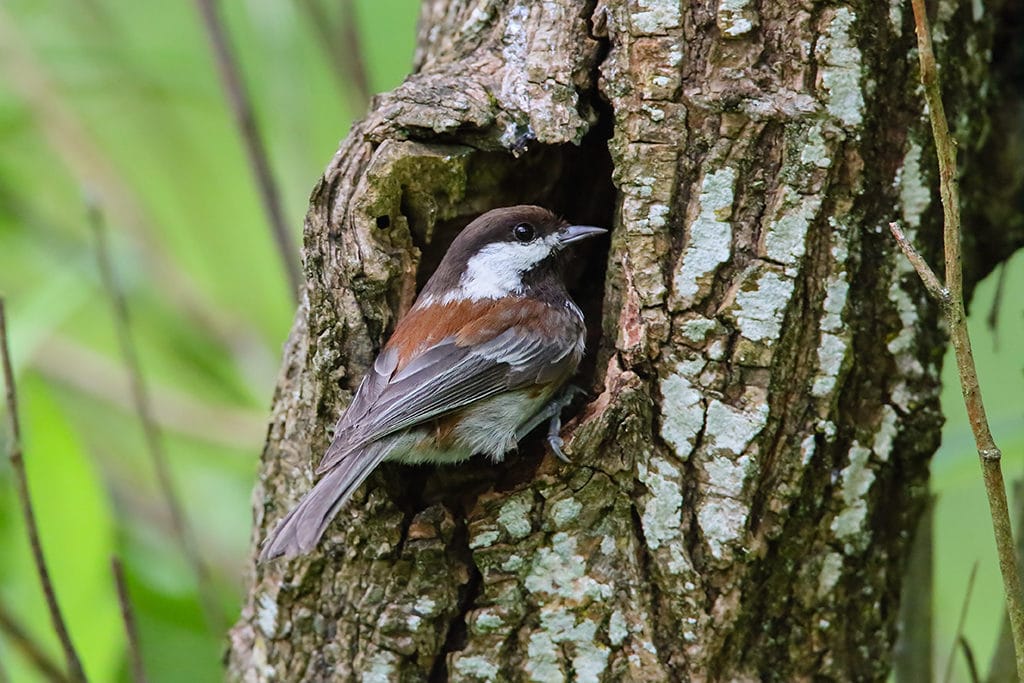
Forest Park
At over 5,100 acres, Forest Park is one of the largest city nature parks in the U.S. The park nearly abuts some of the most bustling Portland neighborhoods near downtown before rising sharply over 1,000 feet into the steep Tualatin Hills just to the west. As the name suggests, nearly all the landscape is covered in forest, ranging from young deciduous woods of maple, black cottonwood, and red alder, to mature stands of western hemlock, western red cedar, and Douglas fir. Consequently, this is one of the best opportunities you will have to encounter a large variety of avian species. Five owl species and about six warbler varieties are thought to regularly inhabit the property, along with the likes of wintering Hermit Thrushes, nesting Pacific-slope Flycatchers, and year-round residing Steller’s Jays and Pacific Wrens. About 70-miles of trails allow visitors to sample different portions of the park, both on flat and steep terrain. Forest Park is also adjacent to, and shares Balch Creek (one of the most pleasant narrow bands of riparian habitat in the forested hills) with the Bird Alliance of Oregon Wildlife Sanctuary.
Birds You Might See or Hear: Northern-pygmy Owl, Steller’s Jay, Wilson’s Warbler, Hermit Thrush, Hermit Warbler, Black-throated Gray Warbler, Pacific-slope Flycatcher.
Location: Many entrance points in Northwest Portland, Including off of West Burnside St, Cornell Road, NW Thurman St, Germantown Road, and NW Upshur St—see here for maps.
Public Transit: The most accessible entrance point from public Transit is the Lower MacLeay Trail, and the now pedestrian Leif Erikson Drive about 6 blocks west of a stop on the 15 and 77 bus routes at Northwest Thurman ST and Northwest 27 Ave. The Forest Park Wildwood trail connects with the adjacent Washington Park to the South, where the trail is served by the 63 Bus at SW Fairview about 2.25 miles of hiking away, and by the Max light rail red and blue lines at the Washington Park stop near the Wildwood trail’s end, three miles south of Burnside.
Trail accessibility: Some paved and wide gravel trails can be found, like the Leif Erikson Drive trail–a former road for vehicles that runs relatively gently for 11 miles through the park. The first couple hundred feet of the Lower MacLeay Trail is ADA accessible as it gently follows scenic Balch Creek and adjacent habitat. Other trails may have steep slopes, stairs, tree roots and puddles.
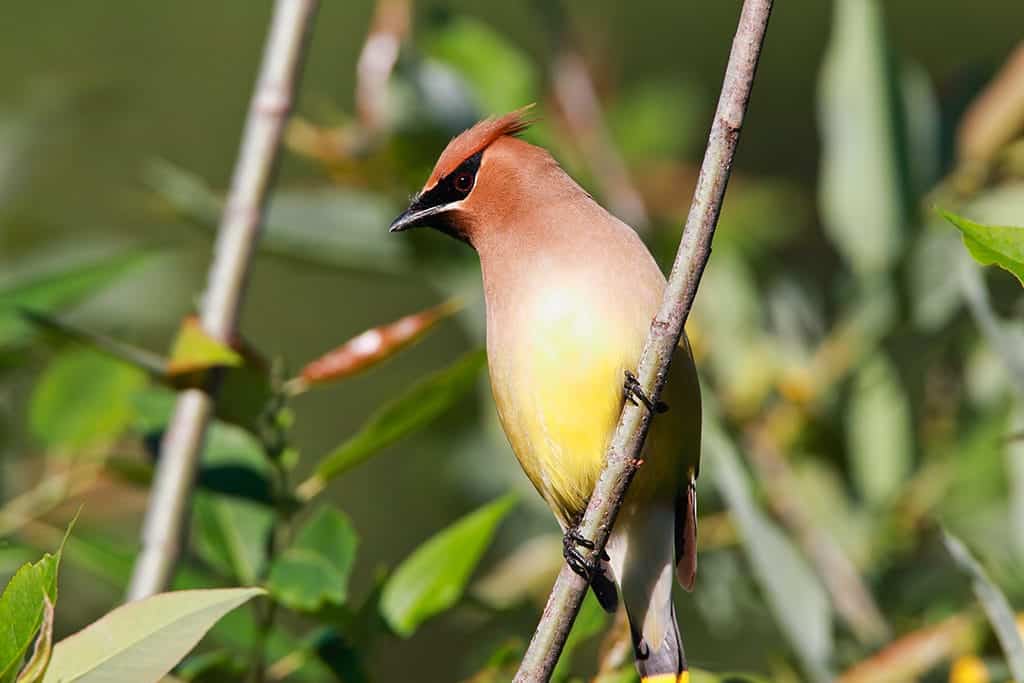
Jackson Bottom Wetlands Preserve
Over 150 birds are detected each year in the 635-acres of wetlands and adjacent woodlands along the Tualatin River in Beaverton, just Southwest of Portland city proper. This land was used extensively for dumping and sewage in the early-mid 20th century, but it has since been protected and managed as wetland habitat. Following nomination from Bird Alliance of Oregon, the site was designated an “Important Bird Area” by Birdlife International. Waterfowl are abound here year-round, with migration changing the variety seasonally. Bald Eagles and upland forest bird species like Wilson’s Warbler can be readily seen.
Birds You Might See or Hear: Great Egret, Great Blue Heron, Greater Yellowlegs, Bald Eagle, Brown Creeper, Cedar Waxwing, Wilson’s Warbler.
Location: 2600 SW Hillsboro Hwy, Hillsboro, OR 97123
Public Transit: Jackson Bottom Wetlands Preserve is .7 miles on the Blue Max Line from the Mark O. Hatfield Government Center Station.
Trail Accessibility: Dirt trails are even and flat in many places, after an initial downhill slope from the visitor’s center.
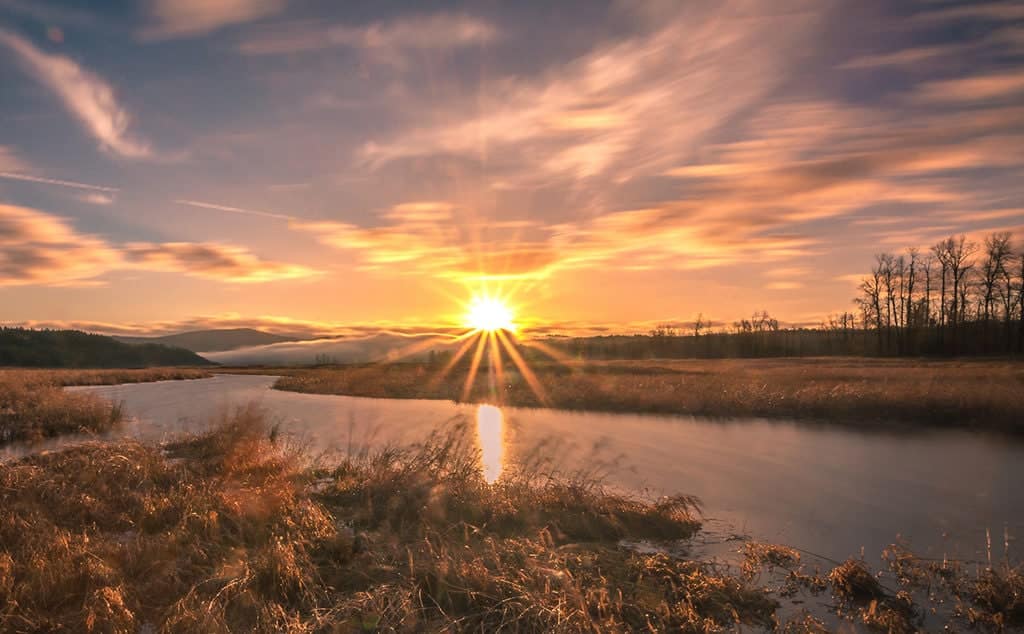
Steigerwald Lake National Wildlife Refuge
These more than 1,000 spectacular acres of land just west of Vancouver make up one of the largest, most popular, and most accessible birding destinations along the Columbia. Its existence is owed in large part to the Vancouver Bird Alliance of Oregon Society, who began purchasing the land upon the organization’s formation in 1975, ten years prior to the to the establishment of the National Wildlife Refuge. The high reputation among birders is accounted for by the mosaic of high quality habitats, including rare examples of flood plain wetlands and extensive lowland and riparian woods of cottonwood and Oregon white oak. Another reason for its popularity may be the fact more than 200 species have been detected here. Along with the diverse and excellent habitat, the high diversity is due to the location being at the point where the Columbia River Gorge meets the Pacific Coast migration Flyway. This means migrating birds from both east and west of the Cascade Mountains find their way here via the low-elevation passages through the high terrain.
Birds You May See or Hear: American Bittern, Green Heron, Lazuli Bunting, Bullock’s Oriole, White-breasted Nuthatch, Yellow-headed Blackbird, Red-shouldered Hawk.
Location: 35001 Lewis and Clark Highway (Washington State Rt. 14), Washougal, Washington—near Highway 14 and 45th Ave.
Public Transit: The C-TRAN Bus 92 has a stop at 45th Ave and Highway 14 in Washougal, just 400 yards west of the trailhead.
Accessibility: There are some very gentle, well maintained trails here with minimal elevation gains, benches, wooden bridges and viewing platforms.
